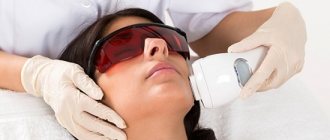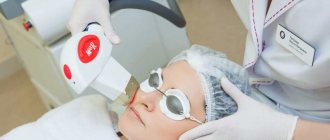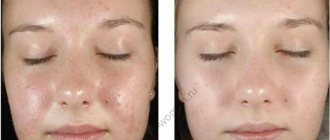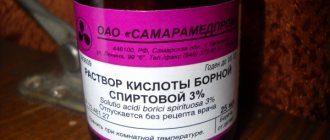From this article you will learn:
- The essence of fractional laser rejuvenation
- 4 types of fractional laser rejuvenation
- Benefits of fractional laser rejuvenation
- Indications for the rejuvenation procedure
- Fractional rejuvenation for the treatment of scars and stretch marks
- Contraindications for such rejuvenation
- Preparation and progress of the procedure
- Number of sessions
- Possible side effects
- 7 tips for post-procedure care
- Approximate prices for fractional laser rejuvenation
- Frequently asked questions about fractional laser rejuvenation
Fractional laser rejuvenation is know-how in cosmetology. The procedure appeared quite recently, but has already proven itself on the positive side. Everyone who wants to rejuvenate the skin of their face, neck, and hands resorts to it. It has many indications and few contraindications.
This type of rejuvenation allows you to smooth the skin, remove scars and scars, and even out the tone. The procedure lasts a few minutes, and the effect lasts up to five years. Isn’t this what many women dream of – visiting a salon and staying beautiful for a long time? In any case, before signing up for a session, you should consult your doctor, as side effects are possible.
The essence of fractional laser rejuvenation
One of the newest modern developments in the field of cosmetology is the technique of fractional laser rejuvenation. Currently, it is not without reason that it can be called the most popular of all laser therapy procedures.
During the session, a laser beam passed through a special fractional grid breaks up into a large number of microbeams. This method provides a targeted (fractional) effect on the skin without completely disrupting it.
Recommended articles on the topic:
- Ultrasonic facial peeling is a pleasant and beneficial procedure for your skin
- Redermalization of the skin: all the pros and cons
- Almond peeling for the face: features of the procedure
Many tiny treatment areas are formed in the dermis layer, where the development of renewed young skin tissue occurs very quickly. Cells located around the affected areas begin intensive division, filling the damaged areas. As a result, rejuvenating processes in the deep layers of the dermis are stimulated. Micro-rays, affecting the middle and upper layers of skin tissue, help eliminate pigmentation, wrinkles and scars.
Fractional laser rejuvenation of facial skin helps it gain firmness and elasticity. In addition, thanks to the procedure, pores are significantly reduced, the oval of the face becomes more toned, the shade and texture of the skin becomes smoother, and wrinkles and scars are significantly smoothed out.
Benefits of fractional laser rejuvenation
This technology has been used in the field of cosmetology for more than 10 years. It is effective, safe and has a number of advantages when compared with other rejuvenating and healing techniques:
- practically does not cause side effects;
- non-invasive, so there is no chance of client infection (including HIV);
- painless and quite comfortable;
- allowed from 16 years of age;
- hygienic, since the instruments do not come into contact with the skin;
- suitable for atonic skin types;
- it is possible to choose an individual treatment program;
- Suitable for clients with any degree of skin pigmentation;
- areas with defects are treated pointwise, so the possibility of damage to healthy tissue around is excluded;
- due to the fact that only 25% of the skin is injured, the recovery period after the procedure is short (face – seven days, body – 14 days);
- the effect becomes noticeable immediately after the first procedure;
- the result obtained lasts for several years;
- it is possible to treat delicate areas;
- in affected areas, elastin production is significantly accelerated.
Myths and truth about the Fraxel procedure
Services Doctors Results Reviews
Expert tested
Avdeyuk Elena Vladimirovna Dermatovenerologist, cosmetologist
Publication date: October 10, 2022
Review date: November 11, 2022
Fraxel fractional photothermolysis technology has been around for 15 years. In fact, fractional photothermolysis is a method of laser skin resurfacing, which perfectly helps to cope with age-related problems, as well as skin defects, such as scars, cicatrices, stretch marks, and age spots.
This unique technology appeared in 2004. It was developed and patented by the American company Reliant Technologies. It is now one of the largest and fastest growing beauty equipment companies in the world. Fraxel lasers, despite the large number of competitors, remain the best and safest.
However, many patients are afraid to undergo laser procedures after reading various “horror stories” on the Internet. Let’s try, together with the doctors of the leading Russian cosmetology clinic “A Clinic”, to figure out what is true and what are myths about the Fraxel procedure.
Myth 1
. Fractional laser is used without any scientifically proven research. Therefore, the technology cannot be considered safe.
Is it true. In fact, laser techniques have been used in cosmetology for many decades, so they are only being improved. Clinical studies conducted by the manufacturer and independent specialists formed the basis for more than 100 scientific publications, 25 FDA approvals (one of the most authoritative organizations in the world monitoring the safety of medical devices), and dozens of reports at international congresses of aesthetic medicine.
The technologies used are unique and protected by more than 30 international and US patents. The company never strives to use outdated technologies or copy competitors' innovations.
The development of new and improvement of existing Fraxel lasers is always preceded by clinical studies and a detailed analysis of the processes occurring in the skin during and after the Fraxel procedure, both at the histological and molecular biological levels. The manufacturing company is always open to doctors working with the Fraxel laser.
Many clinics are already working on the third generation of laser - Fraxel re: store. Fractional laser is absolutely safe, the impact is strictly dosed, and the recovery period is minimal. In addition, there is no getting used to the procedure; it will always be effective.
Myth 2
. Fraxel leaves very severe redness and even burns on the skin.
Is it true. The laser beam does not affect the top layer of skin - the epidermis. In addition, thanks to the principle of fractionation, a thin laser beam does not affect the entire surface of the skin, but micro areas, so there can be no visible damage, much less burns.
During exposure, old and damaged collagen and elastin are destroyed in the micro-area. As a response, the body begins to restore the damaged area - new skin appears, free from defects. Since the diameter of the microdamage is very small and there are many healthy cells around, recovery occurs very quickly and the procedure is safe.
But some patients may still experience redness on the skin. But this is by no means a burn, but a natural reaction of the body to treatment.
The redness looks like a healthy glow and goes away in one or two days, without any discomfort.
Myth 3.
No matter how many Fraxel treatments you do, you still cannot cope with stretch marks, scars and age spots.
Is it true. The principle of the Fraxel laser's effect on age spots and areas of hyperpigmentation differs from all common methods. Fraxel does not act on melanin, but on the cells that synthesize and accumulate this pigment. It destroys these cells. Fraxel effectively treats all forms of hyperpigmentation. In place of the destroyed micro-area of the skin, young cells appear that synthesize and accumulate an adequate amount of pigment. Thus, old cells in which the formation of melanin is impaired are replaced with new ones. In place of the pigment spot, skin of a natural shade is formed. In addition, the process of skin rejuvenation occurs.
Fraxel is recommended for the treatment of pigmentation on the hands, neck, and décolleté.
Scars appear when the skin is damaged deeply enough - deeper than the papillary dermis, or when an extensive wound heals by surface tension. At the same time, the body tries to close the wound as quickly as possible and synthesizes fairly coarse connective tissue. As a rule, scars remain for life. The Fraxel laser destroys the “wrong” scar tissue and stimulates the synthesis of new collagen and elastin in this area and in surrounding tissues. In place of rough, incorrectly formed tissue, a new one appears. After 4-5 procedures, scars, for example, after plastic surgery, disappear completely.
Stretch marks are also a type of scar, but have a finer structure. Stretch marks form in places where skin fibers are torn and separated. Such ruptures can occur during prolonged stretching of the skin, when the connective tissue is under severe stress, or during certain hormonal changes in the body, when the tissue becomes less durable. Stretch marks very often appear in women during pregnancy, when the volume of the abdomen and breasts sharply increases, and changes in hormonal levels contribute to a weakening of the bond in the collagen framework of the skin. If a woman tends to gain weight and then lose weight, then this is also stress for the skin and a reason for the appearance of stretch marks.
Increasingly, stretch marks can be observed in men who, while playing sports, quickly increase muscle mass. The skin simply cannot keep up with the growth in volume and tears occur. Fraxel is capable of destroying scar tissue at a depth of up to 1.5 mm and stimulating the growth of normal tissue at this site.
Zadiran Alina Valerievna
Dermatovenerologist, cosmetologist. Candidate of Medical Sciences
But it is important to remember that in the treatment of stretch marks, success largely depends on their “age”. For example, stretch marks that appear during pregnancy are best treated immediately after the woman has finished breastfeeding. The result is achieved in 4-5 procedures. Fraxel safely removes stretch marks from any area of the body, including the chest and inner thighs.
Myth 4.
Fraxel is a very painful procedure, so it is performed under anesthesia.
Is it true. Anesthesia involves applying a special anesthetic cream to the skin. Since the procedure involves thermal damage to the dermis, it cannot be completely painless. But pain relief with cream is quite enough. This anesthesia makes the Fraxel procedure comfortable: the doctor does his job without causing pain to the patient. The doctor can also additionally use cooling air flows directed into the treatment area.
Myth 5.
The procedure is not suitable for dry skin, as it will turn it into real parchment.
Is it true. This is an absolute myth. Fraxel allows you to work with any skin type. One of its main advantages is the ability to select an individual laser operating mode for each patient and each problem. Peeling after the procedure is very slight, it is invisible to the eyes and does not cause any inconvenience to patients. In addition, combining Fraxel with other methods (for example, mesotherapy, hyalurotherapy) allows you to achieve much greater skin hydration than before the procedure.
Myth 6.
You need to wait almost a year for the effect of the procedure.
Is it true. Each patient is individual. For some, the result is noticeable immediately, and therefore they require fewer procedures. For others, the effect increases gradually, and more procedures are needed. However, there is a general pattern. For most patients, the rejuvenating effect begins to appear from the first procedure and increases as subsequent procedures are performed. The visible effect when correcting scars and stretch marks appears a little later - after two or three procedures. But you certainly won’t have to wait a year.
Myth 7
. Fraxel should not be used on the body.
Is it true. The Fraxel procedure is performed on the eyelids, face, neck, décolleté, hands and forearms. When correcting scars, stretch marks and pigmentation, it can be performed on any part of the body. Usually these are the chest, abdomen and thighs. Less often - shoulders, back, buttocks. It should be borne in mind that the effectiveness of the procedure is always higher in areas of the skin with good blood supply.
Indications for the rejuvenation procedure
Fractional laser rejuvenation can be used for:
- general skin rejuvenation;
- skin lifting (face, neck, décolleté, hands);
- smoothing scars;
- skin smoothing;
- restoration of the oval contour of the face;
- wrinkle removal;
- elimination of pigment spots and melasma;
- removal of stretch marks (striae);
- eliminating the consequences of acne.
As a result of intense exposure to fractional laser, the skin may become hyperpigmented for a short period of time.
To get a good result, after the procedure it is necessary to treat the skin with sunscreen cosmetics with a protection level of at least SPF 50.
Fractional grinding can be compared with continuous grinding in terms of the resulting effect. Judging by the extensive foreign and domestic experience, this hardware technique is less traumatic and leads to an amazing rejuvenating and tightening effect.
Fraxel: indications for the use of fractional laser
Fraxel, like many other fractional lasers (manufactured under other brand names), is commonly used to treat the following problems:
- to reduce wrinkles and deep lines on the face and neck (Fig. 4-5),
- for general skin rejuvenation and increasing its elasticity,
- stretch marks (striae) after pregnancy (Fig. 6),
- scars and scars after operations (Fig. 7),
- acne scars (Fig. 8),
- enlarged pores,
- age spots, melasma (Fig. 9),
- spider veins,
- treatment of skin keratosis.
Fraxel: before and after photos
Fractional rejuvenation for the treatment of scars and stretch marks
This rejuvenation method is especially effective in treating scar tissue. Fractional laser beams have the ability to crush roughened scar tissue, after which it acquires elasticity, softness, and the tension of the surrounding healthy tissue decreases.
Fractional photothermolysis helps reduce the area of scars, making them elastic, unnoticeable, and as close as possible in appearance to healthy skin.
Fractional rejuvenation is indicated for the treatment of stretch marks. Sadly, stretch marks cannot be completely eliminated, you can only make them more invisible.
The effect of fractional treatment is:
- reducing the area of stretch marks;
- reducing tissue fiber breaks;
- aligning the shade of stretch marks with the tone of healthy skin;
- increasing the elasticity and firmness of the skin tissue around and relieving tension.
Contraindications for such rejuvenation
Fractional rejuvenation, like any cosmetic procedure, is not suitable for everyone. Therefore, in order to avoid negative consequences, before the session it is necessary to carefully study all contraindications.
Fractional photothermolysis is not recommended:
- during pregnancy and during breastfeeding, since any changes that occur in the body of a pregnant or lactating woman affect the baby - you should not risk the child’s health, it is better to postpone the procedure;
- in case of inflammation (or redness) in the treated area, the cosmetologist will refuse to carry out fractional laser photothermolysis in the cheek area if they are covered with an allergic rash (the laser beam can damage the skin up to deep scars);
- for chemical peeling - if you have cleansed your face, you need to allow the layers of the epidermis to strengthen for two weeks (minimum) and prepare for exposure to the laser beam;
- in the presence of oncological diseases, since spontaneous complications may arise as a result of laser exposure;
- with diagnosed diabetes mellitus;
- in the presence of viral and bacterial infections - in order to avoid the invasion of foreign elements into the cell structure during fractional rejuvenation, it is first necessary to recover completely.
How Fraxel Fractional Laser Works –
To understand how it all works, you need to know the structure of the skin (Fig. 13). The skin consists of 3 layers: → epidermis (surface layer), → dermis (middle layer), → subcutaneous fatty tissue.
The epidermis consists of numerous layers of keratinocytes of varying degrees of differentiation. The epidermis also contains melanocytes (so-called pigment cells), which are responsible for skin color. The dermis consists of collagen and elastin fibers, fibroblasts, which provide the skin with strength, firmness and elasticity (24stoma.ru).
As our body ages, the appearance and general characteristics of the skin change. The epidermis becomes thinner, various spots on the skin become more noticeable, and the collagen content in the dermis by the age of 45 decreases by almost half. Skin moisture is noticeably reduced due to a decrease in hyaluronic acid content. All this leads to the gradual appearance of wrinkles, the formation of deep lines on the face, and the skin becomes flabby.
Principle of operation -
Using special technology, the laser beam is split into thousands of microbeams, each of which is one-tenth the size of a human hair.
That is why such lasers are called fractional. The meaning of such fractionation is that areas of destroyed tissue are subsequently surrounded by areas of undamaged viable tissue, the cells of which will ensure rapid restoration of damaged areas. When using non-ablative Fraxel lasers (Fraxel refine and Fraxel restore), numerous micro-areas of tissue coagulation (MTZ microthermal zones) are formed - in the form of columns perpendicular to the skin surface (Fig. 14). And when using the Fraxel repair ablative laser, not only injury occurs, but also a certain percentage of tissue is removed, which leads to a pronounced skin lifting effect.
In response to such damage, the body begins to synthesize more proteins, mediators and signaling molecules, which cause the activation of skin stem cells and increase the rate of their division. A large number of new cells begin to gradually synthesize the structural elements of the skin, such as collagen and elastin. Moreover, after using the Fraxel repair ablative laser, these processes are more pronounced.
When using non-ablative Fraxel lasers (Fraxel refine and Fraxel restore), coagulation areas occur predominantly in the dermis without compromising the integrity of the stratum corneum of the epidermis. And when using the Fraxel repair ablative laser, coagulation occurs with a violation of the integrity of the stratum corneum, which leads to the formation of microholes in it up to 200 microns in size, which are completely restored in about 24-45 hours (Fig. 17). Damage to the dermis is restored in 4-7 days.
Preparation and progress of the procedure
To avoid disastrous consequences in the form of complications after a cosmetic procedure, it is necessary to carefully prepare for it.
First, you need to consult with a cosmetologist and get an assessment of the condition of the skin on your face. The specialist will determine a list of contraindications and give the necessary recommendations.
Before the procedure, it is not advisable to visit the bathhouse, sauna, or solarium for 3–4 weeks. In addition, sunbathing in the open sun is prohibited. Before going outside, you need to apply sunscreen to your face.
It is very important to stop taking certain medications, particularly antibiotics and blood thinners. In addition, doctors recommend taking antiherpetic medications.
No later than two weeks in advance, it is not recommended to perform manipulations that injure the skin tissue.
We recommend
Laser hair removal of the abdomen: contraindications, features of the procedure and care Read more
Fractional laser rejuvenation of the eyes and other areas takes place in several stages. First, the cosmetologist must prepare the skin areas for the procedures. To do this, it removes the remnants of decorative cosmetics from the skin, as well as dirt, dust, and sweat. Then the surface is treated with an antiseptic.
The next step is to apply an anesthetic cream, which is left on the skin for about an hour.
After anesthesia, contact gel is evenly applied to the face so that the sensor glides smoothly and evenly over the surface of the skin.
The tip is then used to process the skin tissue in straight lines in several directions. The device is equipped with nozzles of different sizes. Typically, 2 cm² of skin is treated in one pass.
At the end of the procedure, the specialist should remove the remaining contact gel and apply a soothing cream.
Technique
The cosmetologist selects the procedure method, the intensity of radiation, and the treatment area. The client goes through 4 stages:
- Accommodation. The patient lies down on the couch, taking a comfortable position, in which he will spend from 10 to 30 minutes. Hair is removed from the forehead under a disposable cap;
- Facial cleansing. The doctor removes remaining cosmetics, sebum and other contaminants;
- Laser processing. The cosmetologist processes the required areas in scanning mode;
- To reduce redness, a cream with panthenol is applied to the treated area.
Most people experience no pain during the non-ablative rejuvenation process. For a client with sensitive skin, the doctor will provide local anesthesia.
Number of sessions
After fractional laser rejuvenation of the eyelids and other problem areas, rehabilitation of 3–7 days is required. The duration of the rehabilitation period will depend on the patient's lifestyle. For example, bad habits, poor nutrition, excessive physical activity, stress and disturbed sleep can significantly slow down skin regeneration after the procedure.
During the first three days after the session, redness and slight swelling may appear on the skin. To reduce the level of discomfort, you can take painkillers and use skin cooling products.
It is considered normal if during the first week the skin feels tight and peels in some places. Side effects include a bronze tint to the face, which disappears after 14 days.
A lasting result can be achieved by performing two to five procedures. A cosmetologist can tell you exactly how many sessions are needed, depending on each individual case and the client’s initial data.
The interval between sessions should be at least 3-4 weeks. Fractional laser rejuvenation slows down aging: wrinkles decrease or disappear completely, turgor increases, pores narrow, and complexion evens out. This method effectively removes pigmentation, post-acne, stretch marks and scars.
Three modifications of the Fraxel laser –
There are three main original Fraxel devices, which are used in different clinical situations, and depending on the severity of the problem.
Fraxel Re'fine –
This is a fractional non-ablative erbium laser, with a wavelength of 1410 nm and a single pulse energy of 5 to 20 mJ (Fig. 10). This laser works to a depth of 0.7 mm, and the stratum corneum of the epidermis remains intact. This is the softest type of Fraxel laser, after which healing occurs as quickly as possible, and the procedure itself is as painless as possible and lasts only 20 minutes.
Fraxel refine is used to smooth out fine wrinkles around the eyes, tighten the skin of the eyelids, remove age spots and other pigmentation on the skin, and treat melasma. Also, this type of laser generally improves the condition of the skin and can be used primarily to prevent aging.
Thus, the indications for using Fraxel refine are exactly the same as for photorejuvenation techniques using IPL devices. The latter, as a rule, are much cheaper than Fraxel laser treatment. However, Fraxel can be used on people of any skin color, and IPL devices are not recommended for people with dark skin.
Fraxel Restore –
This is a fractional non-ablative erbium laser, with a wavelength of 1550 nm and a single pulse energy of 4 to 70 mJ (Fig. 11). The depth of exposure, depending on the settings, ranges from 0.4 to 1.4 mm. This type of laser is used to treat similar problems that Fraxel refine can eliminate, but only more severe. For example, to smooth out more pronounced wrinkles.
Fraxel restore reviews also claim that it does an excellent job of removing small atrophic acne scars, hypertrophic scars, and is also used to treat stretch marks after pregnancy, pigmentation and skin keratosis.
Fraxel Re'pair –
This is a fractional laser of the ablative type, belongs to the group of CO2 (carbon dioxide) lasers with a wavelength of 10600 nm and a single pulse energy of up to 225 mJ (Fig. 12). Unlike classic ablative lasers, which work only deep into the epidermis, Fraxel Repair works in both the epidermis and dermis. The depth of exposure ranges from 0.4 to 1.6 mm, and it can be adjusted by the settings of the device, on which modes can be selected: “medium ablation” or “deep ablation”.
Medium ablation mode primarily targets the lower layers of the epidermis and upper layers of the dermis, which is suitable for smoothing shallow wrinkles (such as around the eyes), reducing pore size and improving skin texture.
Fraxel repair in the “deep ablation” mode acts primarily on the middle layers of the dermis, which is excellent for smoothing out deep wrinkles. When using this mode, there is also a pronounced skin lifting effect, which you will notice immediately after the procedure. The device is also successfully used to remove age spots and spider veins, as well as to remove hypertrophic scars and scars.
Analogues of the Fraxel Repair laser produced by other manufacturers -
- Active and Deep FX (Lumenis),
- Quadralase (Candela),
- Pearl Fractional (Cutera), etc...
Comparison of Fraxel refine and Fraxel restore – with Fraxel repair…
Fraxel repair fractional ablative CO2 laser is more aggressive than erbium non-ablative lasers Fraxel refine and Fraxel restore, which leads to greater synthesis in tissues of inflammatory mediators, proteins and factors that stimulate stem cells and fibroblast function. Accordingly, the effectiveness of the procedure with the Fraxel ablative CO2 laser will be 2 times higher, although healing will take 2-3 times longer. In addition, it is “Fraxel repair” that gives the best skin lifting effect.
Operation process of fractional CO2 laser: video
Possible side effects
Complications after fractional laser rejuvenation procedures are extremely rare. Most often, negative consequences are observed due to the unprofessional actions of a cosmetologist who neglects the processing instructions. Sometimes side effects occur due to the client's failure to follow skin care recommendations.
Most likely complications:
- severe hyperemia of the skin, which goes away on its own after three days;
- swelling;
- dark skin tone;
- excessive dryness and flaking of the skin;
- burns;
- scars and cicatrices;
- white or yellow milia raised above the surface (dense nodules that form under the skin);
- inflammatory processes in damaged areas;
- the phenomenon of hyperpigmentation (may appear as a result of exposure to sunlight).
Complications after fractional laser rejuvenation will not appear if you prepare well before the procedure, choose a reliable clinic and an experienced professional.
Frequently asked questions about fractional laser rejuvenation
Minimum age allowed for laser facial rejuvenation
There are practically no restrictions. The procedures can be performed as early as 17 years of age to get rid of acne scars.
For women over 40 who want to maintain youth and attractiveness, the technique is especially useful, since laser beams provoke the production of their own collagen by skin cells.
The recovery period after fractional laser rejuvenation is usually 7–14 days. The duration of rehabilitation depends on the complexity of the problem and the type of laser treatment.
When can I start working?
This depends on what type of laser treatment was used, on the area of problem areas, and on the experience and skills of the cosmetologist. The recovery period, based on the method and complexity of the defects, ranges from two days to three weeks. It happens that the patient can start working just a day after the session.
How long does it take to see results?
It takes about six months for the skin to be completely renewed and the effect to become noticeable. The result lasts for about five years.
Fractional laser facial skin rejuvenation is a highly effective cosmetic procedure. It has many advantages compared to similar anti-aging techniques. But you need to know that this procedure is not suitable for everyone and has contraindications. Therefore, you must first consult with a specialist. And to reduce the risk of complications, you should choose only reliable and trusted clinics.
Why clients choose Veronika Herba Beauty and Health Center:
- This is a beauty center where you can take care of yourself at a reasonable cost, while your face and/or body will be treated not by an ordinary cosmetologist, but by one of the best cosmetologists in Moscow. This is a completely different, higher level of service!
- You can receive qualified help at any time convenient for you. The beauty center is open from 9:00 to 21:00, seven days a week. The main thing is to agree with your doctor in advance on the date and time of your appointment.
Sign up for a consultation with a specialist by phone +7 (495) 085-15-13
, and you will see for yourself!










